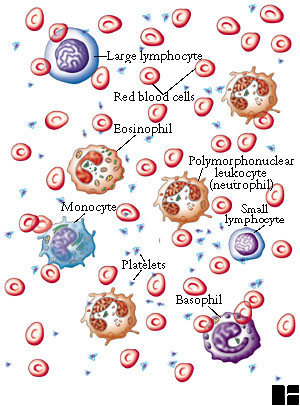
Fig. 01-03 (Kuby Immunology, 3rd ed.)
http://faculty.une.edu/com/abell/histo/histolab3a.htm
The immune system is constituted by a surprising variety of different cell types disseminated throughout the body and collectively defining one's capacity to mount an immune response. All blood cells and certain other cells located throughout the body - particularly in the reticuloendothelial system (RES) - are continuously regenerated throughout life by the process called hematopoiesis. Most hematopoietic cells are short lived, some surviving for only a day or two, and thus hematopoiesis serves to maintain a steady renewal of these cells on physiological demand. Hematopoiesis is believed to be the function of a single precursor cell called the pluripotent stem cell (SC). In addition to being self-renewing, SCs undergo multi-lineage differentiation driven by stage-specific cytokine and cell-cell interactions.
In general, hematopoietic cells are highly mobile, moving with the flow of blood in the cardiovascular system or with the flow of lymph in the lymphatic system. Many of these cells also cross-migrate between these two circulatory systems, and many migrate directly into the tissues, particularly under the influence of inflammatory cytokines with chemoattractive properties. High concentrations of hematopoietic cells, particularly lymphocytes, are also localized in the primary lymphoid organs, i.e., thymus and bone marrow, and secondary lymphoid organs, e.g., spleen, lymph nodes, etc.